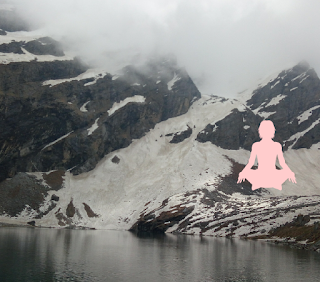Kapậla bhậti; How, keeps the body fit and prolongs life, helps to attain trance like state
Hath yoga comprises of seven practices that gets the aspirant to attain not only internal purification of the body but also external. The words hatha has two Sanskrit’s syllables, Ha means sun and Tha means moon. Sun and moon are related to the major Nadis Ida and Pingla; Ida is a lunar Nadi and Pingla is a solar Nadi, connected to the left and right nostrils respectively. Nadis are the astral tubes that carry psychic currents and the body is filled with such innumerable Nadis that would be between 72000 to 3, 50,000 which cannot be seen by the naked eye and are quite different from nerves, arteries and vein. Among them, are some Nadis which are said to be very important known as Sushumna, Ida, Pingla, Gandhari, Kuhu, Saraswati, Gandhari, Pusha, Varuni, Payasvini, Sankhini, Yasasvini, Vishvodhara and Alambusha.
Sushumna, Ida, and Pingla are the
most important of all. The spine is formed of a series of 33 vertebrae that
have cervical (7 vertebrae), dorsal (12), lumbar (5 vertebrae), sacral (5
vertebrae) and coccygeal (4 vertebrae). The Chakras are connected with the
spine known as the energy centres of the body. Ida Nadi is on the left side of
the spine, Pingla on the right side and Sushumna passes through the hollow
cylindrical cavity of the vertebrae column.
Hatha yoga, Laya yoga, Raj yoga
and mantra yoga are the main forms of yoga. Seven fold practices of hatha yoga
for physical strength and mental perfection are called Shat-karma( Neti,
Dhauti, Nauli, Basti, Trataka, and Kapậla bhậti) for cleaning the body,
asana for strength, Mudra for steadiness, Pranayama for lightness, Pratyahara
for determination, Dhyana (Meditation) for clear awareness of the self and
Samadhi (trance) for ultimate bliss.
Kapầla Bhậti is the last of the shat
karma; kapậla
is head and bhậti is to shine. Kapậla bhậti consists of Rechaka (exhaling) and
Puraka (inhaling) only. To practice, 2 to 5 minutes only are recommended and to
do after Neti. There are two ways to practice Kapậla-Bhati, a slow method and
rapid method. As it holds a considerable spiritual values along with physical.
Jala Neti and dugdh Neti (milk) are recommended by the experts to the
practitioner of kapậla bhati for better results. Nose serves a vital function
in the breathing process as three Nadis run through it, the. Ida, Pingla and
Sushumna. Kapậla bhậti strengthens the pineal and pituitary glands and entire
brain. It also helps the nose by strengthening the temperature regulator;
increasing hormonal secretion as well as toning the body along with beautifying
the skin.
Kapậla bhati keeps the body fit and
prolongs life.
Steps to follow: process 1.
1. Sit comfortably and keep your back
straight.
Close your right nostril with your
thumb of right hand.
Inhale through the left nostril until
you have filled your lungs, this should take about 1 to 2 seconds.
Close the left nostril with your two
fingers middle and ring of your right hand while opening the right nostril.
Exhale slowly through the right
nostril slowly until all air has been released, this should take about 2 to 3
seconds.
The breathing should be quick and
gradual without holding the breath.
Do the same with your right nostril as
inhaling through the right nostril and taking out through the left nostril.
Repeat by alternating between the
nostrils.
2. Now inhale through the left nostril
and inhalation and exhalation should be performed rapidly by the right nostril
for 10 times. Do the same with the left nostril.
Two minutes are enough in the beginning
and build up to 10 minutes.
It can be done when both the nostrils
are open and can be done by using both nostrils, sitting in the siddhasana or
comfortable posture by using Mulabandha and partial uddiyan bandha. Perform
exhalation rapidly; in kapậla bhậti exhalation should be done forcibly and
quickly.
Process 2.
Exhalation is the prime factor of the
exercise; and while inhalation is only the auxiliary part of kapậla bhậti.
Inhalation and exhalation are rapidly done through both nostrils
simultaneously. Exhalation should be done forcibly and quickly by contracting
the abdominal muscles with backward push. A vigorous practice of it just for a
few minutes would vibrate every tissue of the body; and the diaphragm recedes
into the thoracic cavity by expelling all the air from lungs, the abdominal
viscera will be recalibrate easily.
Generally three round are carry out at
each sitting and twice a day enough and as ten or more may be added each week;
that finally 120 expulsions can be done at each round.
Benefits
It helps to awaken certain nerve
centres and further makes the practices of the pranayama more efficiently by
quieting the respiratory centre. A few minutes are enough to induce a trance
state when the aspirant has fully mastered the practice. It purify all the
Nadis of the body.



Nice 👍
ReplyDeleteVery nice Pranayama for respiratory system
ReplyDeleteNice one
ReplyDelete